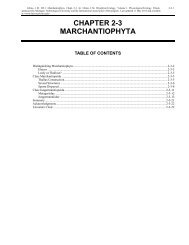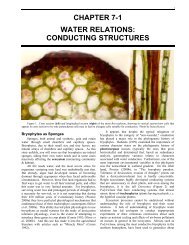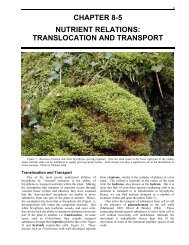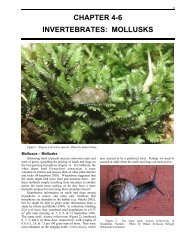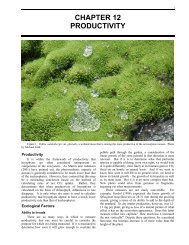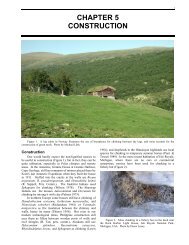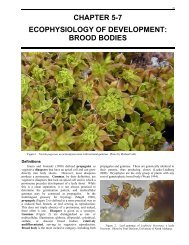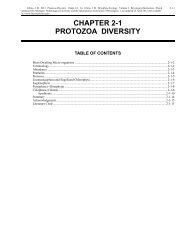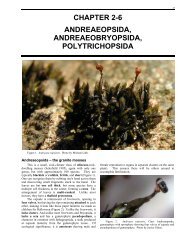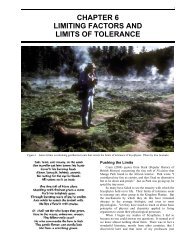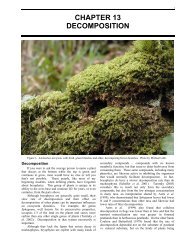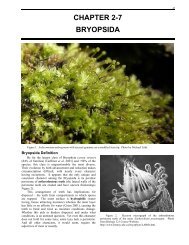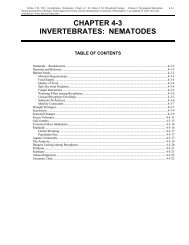Chapter 4-5 Invertebrates Rotifers - Bryophyte Ecology - Michigan ...
Chapter 4-5 Invertebrates Rotifers - Bryophyte Ecology - Michigan ...
Chapter 4-5 Invertebrates Rotifers - Bryophyte Ecology - Michigan ...
Create successful ePaper yourself
Turn your PDF publications into a flip-book with our unique Google optimized e-Paper software.
4-5-14 <strong>Chapter</strong> 4-5: <strong>Invertebrates</strong>: <strong>Rotifers</strong>Claudine Ah-Peng reports that she was surprised tofind invertebrates in the lobules of some species ofLejeuneaceae, notably in the lobules of Acrolejeuneaemergens (Figure 48-Figure 49). These occurred on plantsat the Piton de la Fournaise volcano (Réunion in the IndianOcean) collected on a 1986 lava flow.of these interesting invertebrates (Javier Martínez Abaigar,pers. comm. 2008), as do mosses (Figure 51-Figure 52).Figure 51. Bdelloid rotifer taken from bryophytes. Photoby Dan Spitale.Figure 48. Acrolejeunea emergens with several orangeinvertebrates in the lobules. These appear to be resting stages ofrotifers. Photo by Claudine Ah-Peng.Figure 52. Moss-dwelling rotifer from the moss Sanioniauncinata on the Barton Peninsula of King George Island,Antarctica. Photo by Takeshi Ueno.Figure 49. Acrolejeunea emergens with an emerginginvertebrate, probably a rotifer, in the lobules. Photo by ClaudineAh-Peng.Figure 50. This rotifer, with its "wheels" hidden and its toesshowing, is feeding on detrital material associated with theliverwort Jungermannia cordifolia. Photo by Javier MartínezAbaigar.Lobules are not necessary for rotifer habitation of theleafy liverworts. Jungermannia cordifolia (Figure 50),with only a flat leaf surface to offer, likewise has its faunaDes Callaghan (Bryonet 10 November 2012) kindlyprovided us with a YouTube video of rotifers feeding fromthe lobules of Lejeunea patens in Wales. I knew that theciliated "wheels" directed food into the mouth, but I neverrealized the speed or the distance of that effect. Theparticles started outside the field of view and travelledfarther than the extended length of the rotifer. Someparticles came from near the foot and others shot in like ameteor from the height of the cilia or a little above, butfrom some distance.RoofsColonization of mosses on roofs permittedHirschfelder et al. (1993) to compare species of rotifers onan upright acrocarpous moss (Ceratodon purpureus;Figure 11) and a mat-forming pleurocarpous moss(Brachythecium glareosum; Figure 53). They collectedmosses every two weeks from roofs aged 3-92 years, driedthem at 20ºC, and cut them into small pieces. The pieceswere re-wet in deionized water and examined for theawakening rotifers. The mat-forming moss hadsignificantly more species and greater numbers of rotifersthan did the upright moss, but species on C. purpureusdiffered little from those that could be found on B.glareosum. They found that rotifer colonization of themosses continued for decades and that the colonization bythe mosses was rapid. Nevertheless, the numbers ofspecies increased with time (Figure 54).



